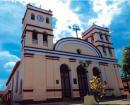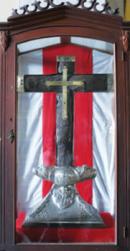- Guantánamo
As the easternmost province of Cuba, it has a varied and attractive tourist product that includes various categories such as nature, cities, patrimonial, and sun and beach tourism. Its capital is the namesake city. It was founded in 1797 by French immigrant settlers fleeing the Haitian Revolution, whose influence can be seen in the architecture and coffee and cocoa plantations that characterize agriculture in the area.
Capital: Guantánamo
Extension: 6 168 km2
Municipalities: Guantánamo, Baracoa, Yateras, Imías, Niceto Pérez, Caimanera, El Salvador, Maisí, Manuel Tames, and San Antonio del Sur.
Denonym: guantanamero/a
Limits: it limits to the north with the provinces of Las Tunas and Holguín, to the east with the provinces of Holguín and Santiago de Cuba, to the south with the province of Santiago de Cuba and the Caribbean Sea, and to the west with the Golfo de Guacanayabo.
Access: it can be accessed by air through Mariana Grajales and Gustavo Rizo airports, while by land is linked to the rest of the country by the national road network and by the rail system.
Places of interest
Parque Martí (Park)
Calixto García, Pedro Pérez, Flor Crombet and Aguilera streets
It is the main square of the city surrounded by the main buildings of the city.
Iglesia Parroquial de Santa Catalina de Ricci (Church)
Aguilera between Calixto García and Pedro Pérez streets
It stands out for the beauty of its ornaments and for the ornamentation of its ceilings. This church is considered to be the smallest in the world.
Palacio Salcines
802-804 Pedro Agustín and Silverio del Prado streets
It is one of the most remarkable constructions of the Historic Center of the City. It is named after engineer and architect José Leticia de Jesús Salcines, who was in charge of its construction between 1916 and 1918. Its most important element is the sculpture La Fama that crowns the dome of the palace, made exclusively for this building by Italian sculptor Américo J. Chini. Because of its artistic and cultural importance and based on a popular survey, this sculpture became the symbol of the city since December 1, 1993.
Museo Provincial (Museum)
804 Martí between Prado and Aguilera streets, Tel 021 32 5872
This building dates from 1862 and was once a prison. It exhibits pre-Columbian pieces and objects related to the natural history of the region and has interesting collections of tobacco bands. Among its attributes is a bas-relief that depicts a map of the US Naval Base located on the Bay of Guantánamo and the Cuban defensive system. In the lobby, there is a Harley Davidson motorbike that belonged to revolutionary Captain Asdrúbal.
Iglesia La Milagrosa (Church)
812 Paseo between San Gregorio and Cuartel streets
With a markedly rationalist style, the building was made with reinforced concrete with a triangular roof, reminiscent of the “vara en tierra” style. Its privileged location on one of the heights of the city, make it is a true urban accident. From a slight height, from any point of the city, anyone can observe its tower topped with a Latin cross. Since 2008, it is the seat of Guantánamo-Baracoa bishopric.
Zoológico de Piedra (Stone Zoo)
Finca San Lorenzo, Municipality of Yateras
Built by the self-taught sculptor Ángel Iñigo Blanco, it is located in the municipality of Yateras, 24 km from the city of Guantánamo. It represents animals carved in stone placed in recreations of their natural habitats. It was inaugurated on December 21, 1977, and has more than 400 statues ranging from huge lions, elephants and snakes to tiny animals.
Parque Nacional Alejandro de Humboldt (National Park)
Located between the provinces of Holguin and Guantánamo is one of the most important natural parks in the Caribbean. With a high degree of conservation, the park has one of the highest plant densities and a high percentage of endemism considered among the highest in the world. You can find there 2% of the species of the flora of the planet. The park is the fundamental nucleus of the Reserva de la Biosfera Cuchillas del Toa, declared by UNESCO World Heritage Site.
Baracoa
The first of the villas founded by Diego Velázquez on August 15, 1511, is located between the Miel river and the mountains. Initially known as the Villa de la Asunción de Baracoa, it was the first political capital of the island until 1515. Its urban center is Monumento Nacional (National Monument.) In its Parochial church, they keep the only remaining Cruz de Parra (Cross of Parra) of the 29 that Columbus placed after its arrival to America. It is considered the oldest historical-religious relic of the encounter between the European and American cultures. Other places of interest for nature tourism are the Paso de los Alemanes, and El Yunque de Baracoa. It is the only area of the country where you can still appreciate the features of the first inhabitants of the island, as well as some vestiges of their culture.
Fuerte Matachín, Museo Municipal (Fortress and Museum)
Martí and Malecón streets
Located northeast of the city of Baracoa, on Punta de Esteban and in front of the cove of the Miel river, it was the second fortification built by royal decree. It has been known as Matachín since the beginning of the nineteenth century, because according to local sources each day two cattle were sacrificed to feed the Spanish soldiers. It was inaugurated as a Museo Municipal (Municipal Museum,) on October 18, 1981 and it has ever since collected the history of the Ciudad Primada de Cuba (Primate City of Cuba.) Main features are samples of the Indo-Cuban culture, the history of the famous Russian lady (who came and stayed here) and the collections of indigenous flora and fauna of the territory such as the polymites and the solenodon.
Castillo de Seboruco de Santa Bárbara (Castle)
Calixto García street, Reparto Paraíso
Located in the northeast part of the city, on a more than 100 m.a.s.l. hill, it is the third building of the defensive system erected in the villa in the eighteenth century, being the most important of all. In the 70's of the twentieth century it was turned into a hotel that was rehabilitated in 1992 and which is part of the tourist center of the area. It offers a magnificent view of the city and its surroundings.
Fuerte La Punta (Fortress)
Punta de Buren
It was part of the defensive system of the city in the eighteenth century and is located northeast of Baracoa, at Punta de Buren at the entrance of the port. It now houses a restaurant.
Parroquia Nuestra Señora de la Asunción de Baracoa
Plaza Principal
Located in front of the main square of the city, it was built in 1807. Destroyed in August 1833, it was repaired in 1886 and at the beginning of the twentieth century two lateral towers were added in the form of narrow pyramids, which do not exist at present. It treasures the Cruz de Parra (Cross of Parra,) the oldest historical-religious relic of the encounter between the old and the new world.











